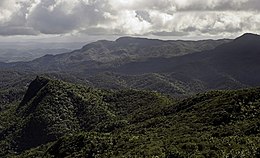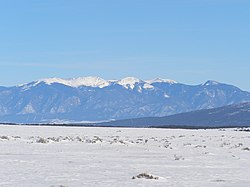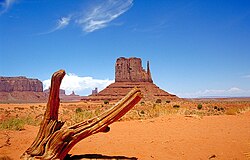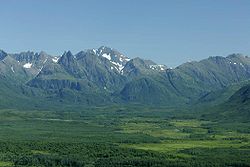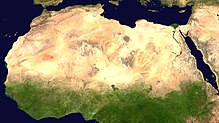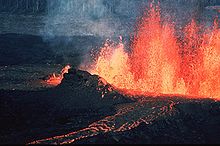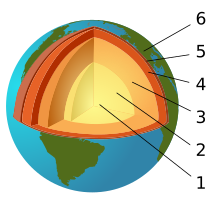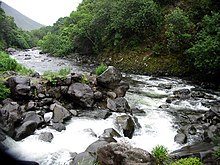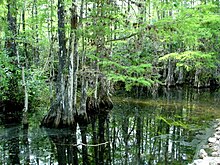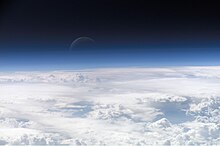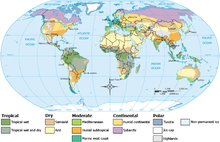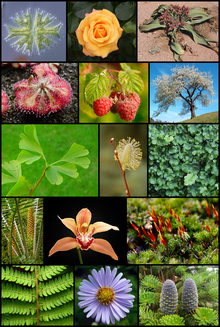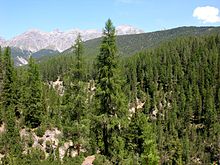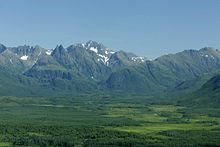| National Wildlife Refuge System | |
|---|---|
IUCN category IV (habitat/species management area)
| |

Official logo
| |
| Location |  United States United States |
| Area | over 150 million acres |
| Established | 1903 |
| Visitors | 47 million (in FY 2014) |
| Governing body | U.S. Fish and Wildlife Service |
National Wildlife Refuge System is a designation for certain protected areas of the United States managed by the United States Fish and Wildlife Service. The National Wildlife Refuge System is the system of public lands and waters set aside to conserve America's fish, wildlife, and plants. Since President Theodore Roosevelt designated Florida's Pelican Island National Wildlife Refuge as the first wildlife refuge in 1903, the system has grown to over 568 national wildlife refuges and 38 wetland management districts encompassing more than 150,000,000 acres (607,028 km2).
Background
The
mission of the refuge system is "To administer a national network of
lands and waters for the conservation, management, and where
appropriate, restoration of fish, wildlife, and plant resources and
their habitats within the United States for the benefit of the present
and future generations of Americans" (National Wildlife Refuge System
Improvement Act of 1997). The system maintains the biological integrity,
diversity, and environmental health of these natural resources and
enables for associated public enjoyment of these areas where compatible
with conservation efforts.
National Wildlife Refuges manage a full range of habitat types,
including wetlands, prairies, coastal and marine areas, and temperate,
tundra, and boreal forests. The management of each habitat is a complex
web of controlling or eradicating invasive species, using fire in a
prescribed manner, assuring adequate water resources, and assessing
external threats such as
development or contamination.
Among these, hundreds of national refuges are home to some 700
species of birds, 220 species of mammals, 250 reptile and amphibian
species, and more than 1000 species of fish. Endangered species are a
priority of National Wildlife Refuges in that nearly 60 refuges have
been established with the primary purpose of conserving 280 threatened
or endangered species.
National Wildlife Refuges are also places where visitors can
participate in a wide variety of outdoor recreational activities. The
National Wildlife Refuge System welcomes nearly 50 million visitors each
year. The system manages six wildlife-dependent recreational uses in
accordance with the National Wildlife Refuge System Improvement Act of
1997, including hunting, fishing, birding, photography, environmental education,
and environmental interpretation. Hunters visit more than 350 hunting
programs on refuges and on about 36,000 waterfowl production areas.
Opportunities for fresh or saltwater fishing are available at more than
340 refuges. At least one wildlife refuge is in each of the 50 states.
National Wildlife Refuge System employees are responsible for planning, biological monitoring and habitat conservation,
contaminants management, visitor services, outreach and environmental
education, heavy equipment operation, law enforcement, and fire
management.
The National Wildlife Refuge System is dealing with such issues as urban intrusion/development, habitat fragmentation, degradation of water quantity and quality, climate change, invasive species, increasing demands for recreation, and increasing demands for energy development. The system has had numerous successes, including providing a habitat for endangered species, migratory birds,
plants, and numerous other valuable animals, implementation of the NWRS
Improvement Act, acquisition and protection of key critical inholdings,
and establishing leadership in habitat restoration and management.
The agency has created Comprehensive Conservation Plans (CCPs)
for each refuge, developed through consultation with private and public
stakeholders. These began a review process by stakeholders beginning in
2013. The CCPs must be consistent with the Fish and Wildlife Service
(FWS) goals for conservation and wildlife management.
The CCPs outline conservation goals for each refuge for 15 years
into the future, with the intent that they will be revised every 15
years thereafter. The comprehensive conservation planning process
requires several phases, including a scoping phase, in which each refuge
holds public meetings to identify the public’s main concerns; plan
formulation, when refuge staff and FWS planners identify the key issues
and refuge goals; writing the draft plan, in which wildlife and habitat
alternatives are developed, and the plan is submitted for public review;
revision of the draft plan, which takes into consideration the public’s
input; and plan implementation.
Each CCP is required to comply with the National Environmental Policy Act (NEPA)
and must contain several potential alternatives to habitat and wildlife
management on the refuge, and identify their possible effects on the
refuge. Additionally, NEPA requires FWS planners and refuge staff to
engage the public in this planning process to assist them with
identifying the most appropriate alternative.
Completed CCPs are available to the public and can be found on the FWS website.
History
Management activities (as of September 30, 2015)
Pelican Island in Florida was the nation's first wildlife refuge, created in 1903.
Comprehensive wildlife and habitat management demands the integration
of scientific information from several disciplines, including
understanding ecological processes and monitoring status of fish,
wildlife, and plants. Equally important is an intimate understanding of
the social and economic drivers that impact and are affected by
management decisions and can facilitate or impede implementation
success. Service strategic habitat conservation planning, design, and
delivery efforts are affected by the demographic, societal, and cultural
changes of population growth and urbanization, as well as people’s
attitudes and values toward wildlife. Consideration of these factors
contributes to the success of the service’s mission to protect wildlife
and their habitats.
The refuge system works collaboratively internally and externally
to leverage resources and achieve effective conservation. It works with
other federal agencies, state fish and wildlife agencies, tribes,
nongovernmental organizations, local landowners, community volunteers,
and other partners. Meaningful engagement with stakeholders at a
regional, integrated level adds to the effective conservation
achievements of the FWS and allows individual refuges to respond more
effectively to challenges.
Wildlife and habitat management activities include:
- Monitoring plant and animal populations
- Restoring wetland, forest, grassland, and marine habitats
- Controlling the spread of invasive species
- Reintroducing rare fish, wildlife and plants to formerly occupied habitats
- Monitoring air quality
- Investigating and cleaning contaminants
- Preventing and controlling wildlife disease outbreaks
- Assessing water quality and quantity
- Understanding the complex relationship between people and wildlife through the integration of social science
- Managing habitats through manipulation of water levels, prescribed burning, haying, grazing, timber harvest, and planting vegetation
During fiscal year 2015, the refuge system manipulated 3.1 million
acres of habitat (technique #9 from the preceding list) and managed 147
million acres of the system without habitat manipulation (using
techniques #1 through 8 from the preceding list).
- Uplands managed: 1.9 million acres
- Wetlands managed: 1.0 million acres
- Open water managed: 0.2 million acres
- Treated by prescribed burning: 0.3 million acres
- Treated to control invasive plants: 0.2 million acres
- Protected but not manipulated: 147 million acres
Refuges attract nearly 50 million visitors each year who come to
hunt, fish, observe, and photograph wildlife, and are a significant boon
to local economies. According to the FWS's 2013 Banking on Nature Report,
visitors to refuges positively impact the local economies. The report
details that 47 million people who visited refuges that year:
- Generated $2.4 billion of sales in regional economies
- Supported over 35,000 jobs
- Generated $342.9 million in tax revenues at the local, county, state, and federal levels
- Contributed a total of $4.5 billion to the nation’s economy
The refuge system has a professional cadre of law enforcement
officers that supports a broad spectrum of service programs by enforcing
conservation laws established to protect the fish, wildlife, cultural,
and archaeological resources the service manages in trust for the
American people. They also educate the public about the FWS’s mission,
contribute to environmental education and outreach, provide safety and
security for the visiting public, assist local communities with law
enforcement and natural disaster response and recovery through emergency
management programs, and help protect native subsistence rights. They
are routinely involved with the greater law enforcement community in
cooperative efforts to combat the nation's drug problems, address border
security issues, and aid in other security challenges.
Prevention and control of wildland fires is also a part of refuge
management. Completion of controlled burns to reduce fuel loading, and
participation in the interagency wildland fire suppression efforts, are
vital for management of refuge lands.
A considerable infrastructure of physical structures is also
essential to proper management of refuge lands. As of September 30,
2015, the refuges had 13,030 roads, bridges, and trails; 5,284
buildings; 8,007 water management structures; and 7,886 other structures
such as visitor facility enhancements (hunting blinds, fishing piers,
boat docks, observation decks, and information kiosks). The overall
facility infrastructure is valued at nearly $30 billion.
Physical features
- Area of land and water under management: 150.3 million acres
- Number of management units: 562 refuges and 38 wetland management districts
- Number of wilderness areas: 74
- Area of wilderness: 20.7 million acres
- Length of rivers within the National Wild and Scenic Rivers System: 1,086 miles (1,748 km)
- Length of refuge boundary with Mexico: 120 miles (190 km)
The area of the refuge system is heavily influenced by large areas
devoted to protecting wild Alaska and to protecting marine habitats in
the Pacific Ocean; however, the number of units and public visitation
overwhelmingly occurs in the lower 48 states, though these refuges and
wetland management districts constitute only a little over 1% of the
system.
| Geographic area | No. of units | Size of NWRS (Sept 30, 2014) | Notes |
|---|---|---|---|
| State of Alaska | 16 | 76.9 million acres | 51% of total refuge system acres are in AK; about 18% of AK is set aside as national wildlife refuges |
| Hawaii and Pacific Marine Areas | 22 | 54.8 million acres | 37% of total refuge system acres are located in the Pacific; nearly all these acres are in four marine national monuments; these areas are predominantly coral reefs and open ocean. |
| Puerto Rico, Virgin Islands, Navassa NWR | 9 | 0.4 million acres | Largest refuge is Navassa Island, which is nearly 365,000 acres |
| Lower 48 states | 553 | 18.3 million acres | 12% of total NWRS acres are in the lower 48 states; the NWRS constitutes about 0.9% of lower 48 acreage. By unit count, 92% of NWRS units are in the lower 48; 515 are refuges (14.2 million acres) and 38 wetland management districts (3.8 million acres). |
| Entire refuge system | 600 | 150.3 million acres | 568 refuges and 38 wetland management districts |
Visitation
- Wildlife observation visits in FY 2014: 29.8 million
- Nature photography visits in FY 2014: 8.4 million
- Fishing visits in FY 2014: 6.7 million
- Interpretive program visits in FY 2014: 2.8 million
- Hunting visits in FY 2014: 2.4 million
- Environmental education visits in FY 2014: 0.7 million
- Total visits in FY 2014: 47 million
Volunteers
- Total volunteers in FY 2014: 36,000
- Total volunteer hours in FY 2014: 1.4 million
Personnel
- Total staff: 3,036 full-time equivalents, thus two half-time employees count as one FTE; FY 2015 total
- Number of Federal Wildlife Officers: 256 (source: Washington office)
- Number of firefighters: 460 (360 permanent and 100 temporary staff)
Special designation areas
In
addition to refuge status, the "special" status of lands within
individual refuges may be recognized by additional designations, either
legislatively or administratively. Special designation may also occur
through the actions of other legitimate agencies or organizations. The
influence that special designations may have on the management of refuge
lands and waters may vary considerably.
Special designation areas within the refuge system as of September 30, 2014, included:
- Biosphere reserves (three units)
- Maine Protected Areas (106 units)
- National Historic Landmarks (10 units)
- National Monuments (seven units)
- National Natural Landmarks (43 units)
- National Recreation Trails (72 units)
- National Wild and Scenic Rivers (13 units)
- RAMSAR Wetlands of International Importance (26 units)
- Research natural areas (207 units)
- Western Hemisphere Shorebird Reserve Network (19 units)
- Wilderness areas (74 units) (the system has 20.7 million acres of wilderness, 19% of U.S. wilderness)
- World Heritage sites (1 unit)





